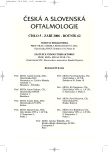The Human Lens’ Transparence Changes in Children, Adolescents, and Young Adults with Diabetes Mellitus Type I
Authors:
J. Krásný 1,2,6; E. Vyplašilová 3; R. Brunnerová 1; J. Madunický 3; Z. Domínek 1; Š. Průhová 4,6; L. Trešlová 5,6; L. Dittertová 4,6; M. Anděl 5,6; J. Lebl 4,6
Authors‘ workplace:
Oční klinika FN Královské Vinohrady a 3. LF UK, Praha
přednosta prof. MUDr. P. Kuchynka, CSc.
1; Katedra oftalmologie Institutu postgraduálního vzdělávání
ve zdravotnictví, Praha
přednosta prof. MUDr. P. Kuchynka, CSc.
2; Oční klinika 1. LF UK a ÚVN, Praha
přednosta doc. MUDr. plk. J. Pašta, CSc.
3; Klinika dětí a dorostu FN Královské Vinohrady a 3. LF UK, Praha
přednosta prof. MUDr. J. Lebl, CSc.
4; 2. interní klinika FN Královské Vinohrady a 3. LF UK, Praha
přednosta prof. MUDr. M. Anděl, CSc.
5; Centrum pro výzkum diabetu, metabolismu a výživy
3. LF UK, Praha
vedoucí prof. MUDr. M. Anděl, CSc.
6
Published in:
Čes. a slov. Oftal., 62, 2006, No. 5, p. 304-314
Overview
Authors followed up the changes’ development of the human lens’ transparence in 213 children and young adult patients with diabetes mellitus type I. As initial changes of the lens’ transparence they considered the posterior “Y” suture accentuation, because it was noticed in 44.4 % of lenses during the first 10 years of the metabolic disease duration, in contrast to 28.1 % representation of this dissociation in the control group of patients without diabetes (p = 0.012), and it was always markedly more often in patients with myopia. Substantial changes were detected predominantly during the sixth until the tenth year of duration of the basic disease as fine subcapsular opacities graded as first degree of lens transparency changes in 48 % of eyes. After 10 years of the disease duration, the lenses were never clear. Consequently, the changes in the transparency in the anterior subcapsular layer associated in 18 %. After 15 years of diabetes duration, we detected opacities in the anterior and posterior subcapsular layers of the lenses, graded as second degree of lenses transparence changes in 85 % of eyes. This subjective evaluating of lenses’ opacity changes by means of the slit lamp examination was correlated with densitometric examination by means of Pentacam camera in a representative sample of 29 patients. In the first degree of lenses’ transparence changes, the posterior subcapsular layer was affected in 50 %, and in the second degree, the opacities in this layer were found practically in 90 % of cases. False positive result in clear lenses or congenital opacities or “Y” suture was not detected. In general, the affected lens transparency did not basically influence the visual acuity and the decrease of contrast sensitivity was not statistically significant (p = 0.34). For the initial change of the lenses’ transparency is also determining the patient’s age at the onset of the diabetes mellitus type I. The changes are more common if the onset of the disease is after the fifteenth year of age as before that (p = 0.026). The authors also detected sporadic opacities in 4.2 % of eyes, probably of congenital origin (out of them, in two patients there was bilateral finding of the cerulean cataract) without visual acuity decrease.
Key words:
diabetes mellitus type I, cataract, congenital cataract, contrast sensitivity, densitometry, opacities of the lens, “Y” – suture of the lens
Labels
OphthalmologyArticle was published in
Czech and Slovak Ophthalmology

2006 Issue 5
Most read in this issue
- The Use of Accommodative Lenses for Surgical Correction of the Presbyopia Using the Prelex Method
- Ocular Symptoms as an Indication for Carotid Endarterectomy
- Clinical Appearance and Outcome of Zone 1 ROP
- The Quality of Vision in Premature Infants – First Results
